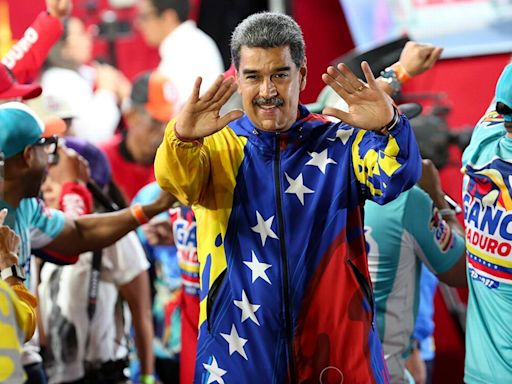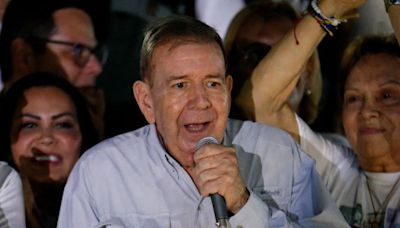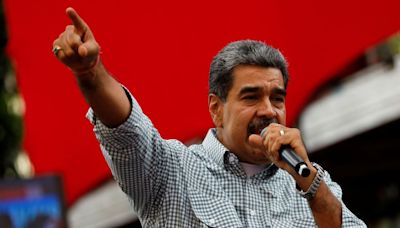Search results
Venezuela is located in the north of South America; geologically, its mainland rests on the South American Plate. It has a total area of 916,445 km 2 (353,841 sq mi) and a land area of 882,050 km 2 (340,560 sq mi), making Venezuela the 33rd largest country in the world.
- President of Venezuela
The president of Venezuela (Spanish: Presidente de...
- 2019 Presidential Crisis
The Venezuelan presidential crisis was a political crisis...
- Venezuelan Bolívar
The bolívar [boˈliβaɾ] is the official currency of...
- Caracas
Caracas (/ k ə ˈ r æ k ə s,-ˈ r ɑː k-/ kə-RA(H)K-əs,...
- Flag
The current eight-star flag of Venezuela was introduced in...
- Foreign Relations of Venezuela
The foreign relations of Venezuela had since the early...
- Demographics of Venezuela
Venezuela is a country in South America. The Venezuelan...
- Crisis in Venezuela
An ongoing socioeconomic and political crisis began in...
- Afro-Venezuelan
Afro-Venezuelans (Spanish: Afrovenezolanos) are Venezuelans...
- Bolivarian Diaspora
During the 20th century, "Venezuela was a haven for...
- President of Venezuela
Venezuela, oficialmente República Bolivariana de Venezuela, [5] [n 2] es un país soberano situado en la parte septentrional de América del Sur y el Caribe, constituido por un área continental y por un gran número de islas e islotes en el mar Caribe, cuya capital y mayor aglomeración urbana es la ciudad de Caracas.
- Pre-Columbian Period in Venezuela
- Spanish Rule
- Venezuelan Independence
- 1830–1908
- 1908–1958
- 1958–1999
- 1999–Present
- See Also
- Further Reading
- External Links
Archaeologists have discovered evidence of the earliest known inhabitants of the Venezuelan area in the form of leaf-shaped flake tools, together with chopping and plano-convex scraping implements exposed on the high riverine terraces of the Pedregal River in western Venezuela. Late Pleistocene hunting artifacts, including spear tips, come from a s...
Christopher Columbus sailed along the eastern coast of Venezuela on his third voyage in 1498 and explored most of the today's Sucre state coast line, the only one of his four voyages to reach the South American mainland. This being the first time that Europeans sighted the continent, Columbus, upon observing the variety of flora and fauna of the Or...
Word of Spain's troubles in 1808 in the Napoleonic Wars but only on 19 April 1810 did its "cabildo" (city council) decide to follow the example set by the Spanish provinces two years earlier. On 5 July 1811, seven of the ten provinces of the Captaincy General of Venezuela declared their independence in the Venezuelan Declaration of Independence. Th...
Following the Venezuelan War of Independence (part of the Spanish American wars of independence), Venezuela initially won independence from the Spanish Empire as part of Gran Colombia. Internal tensions led to the dissolution of Gran Colombia in 1830–31, with Venezuela declaring independence in 1831. For the rest of the nineteenth century, independ...
Juan Vicente Gómez
In 1908, President Cipriano Castro was too sick to be cured in Venezuela and he left for Germany leaving Juan Vicente Gómezin charge. Castro had not gone further than the outer Antilles when Gómez took over the government and forbade Castro from returning. This was the beginning of a regime that lasted until 1935 and is interwoven with the early development of the oil industry, the greatest influence ever on the history of Venezuela. One of Gómez's first measures was to start canceling outsta...
López Contreras and Medina Angarita
Gómez's minister of war, Eleazar López Contreras, succeeded him: a tall, thin, disciplined soldier with a solid education. Before arriving at his post, he served the Gomecista government loyally wherever he was sent, including at one time Venezuela's eastern land's end, a village called Cristobal Colón, across from Trinidad. In power, López Contreras allowed the pardo masses to vent for a few days before clamping down. He had Gómez's properties confiscated by the state, but the dictator's rel...
El Trienio Adeco
El Trienio Adeco was a three-year period in Venezuelan history, from 1945 to 1948, under the government of the popular party Democratic Action (Accion Democratica, its adherents adecos). The party gained office via the 1945 Venezuelan coup d'état against President Isaías Medina Angarita and held the first elections with universal suffrage in Venezuelan history. The 1947 Venezuelan general election saw Democratic Action formally elected to office, but it was removed from office shortly after i...
Second Andrés Pérez administration
Serving as president from 1974 to 1979, Carlos Andrés Pérez proved less generous with hand-outs than previously. Despite initially rejecting liberalization policies,[better source needed] his economic agenda was later focused on cutting subsidies, privatizations, and legislation to attract foreign investment. Naím began at the lowest rung of economic liberalization, which was freeing controls on prices and a ten percent increase in that of gasoline, which in Venezuela is sacrosantly very low....
Second Caldera administration
Caldera, who had been candidate for the presidency six times and won once, wanted another go, but COPEI resisted, led by Herrera Campins, and Caldera founded his own brand-new political movement, called Convergencia. COPEI chose a mediocrity from within its ranks. The adecos chose Claudio Fermín. Petkoff had seen the futility of trying again and backed Caldera. Even Velázquez got into the act. When the returns were in, Caldera won and in the process shattered the strict bipolarity thesis. Abs...
Chávez and the Bolivarian Revolution
Chávez, a former paratroop lieutenant-colonel who had led an unsuccessful coup d'état in 1992, was elected president in December 1998 on a platform that called for the creation of a "Fifth Republic", a new constitution, a new name ("the Bolivarian Republic of Venezuela"), and a new set of relations between socioeconomic classes. In 1999, voters approved a referendum on a new constitution and in 2000, re-elected Chávez, also placing many members of his Fifth Republic Movement party in the Nati...
Arroyo Abad, Leticia. "Instability, Cost of Living, and Real Wages in Venezuela in the 19th Century." América Latina en la historia económica20.3 (2013): 114–137.Carroll, Rory. Comandante: Hugo Chávez's Venezuela(Penguin Books, 2014).Cromwell, Jesse. The Smugglers' World: Illicit Trade and Atlantic Communities in Eighteenth-century Venezuela(UNC Press Books, 2018).Derham, Michael. "Undemocratic democracy: Venezuela and the distorting of history." Bulletin of Latin American Research21.2 (2002): 270–289.Latin American Network Information Center. "Venezuela: History". USA: University of Texas at Austin.
Venezuela is a country in northern South America. It's official name is República Bolivariana de Venezuela (Bolivarian Republic of Venezuela). The official language is Spanish, and the capital is Caracas.
Venezuela is a presidential republic consisting of 23 states, the Capital District and federal dependencies covering Venezuela's offshore islands. Venezuela is among the most urbanized countries in Latin America; the vast majority of Venezuelans live in the cities of the north and in the capital.
Venezuela (denumire oficială: República Bolivariana de Venezuela) este o țară situată în nordul Americii de Sud, cuprinzând terminațiile nordice ale Munților Anzi (care depășesc 5000 m), câmpia fluviului Orinoco și Podișul Guyanelor (care ajunge la 3000 m), dispuse în ordine de la nord-vest spre sud-est. Pe un afluent al râului ...
People also ask
Where is Venezuela located?
What is the history of Venezuela?
How big is Venezuela?
How many states does Venezuela have?
Venezuela is a country in South America, bordering the Caribbean Sea and the North Atlantic Ocean, between Colombia and Guyana. It is situated on major sea and air routes linking North and South America.






